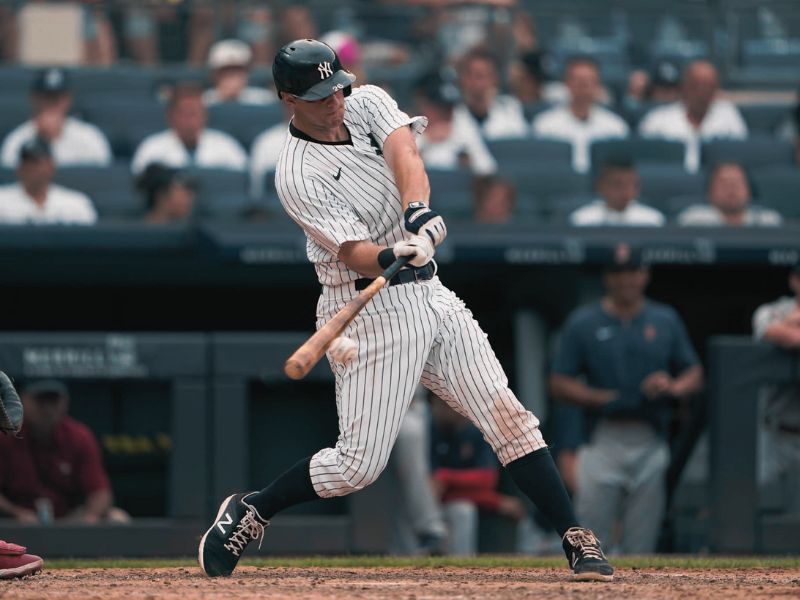Last Updated on September 22, 2023
“A high RISP means a clutch hitter or a dominant pitcher, while a low RISP means a struggling hitter or a vulnerable pitcher.” – Jon Miller, ESPN. What Is RISP in Baseball, and why does it matter?
RISP, or Runners In Scoring Position, is one of those baseball statistics that can turn the tide of a game in an instant. RISP can make or break your game, as it shows how well a team can capitalize on scoring opportunities or prevent them from happening.
I remember being at a game where the home team was trailing by one run in the ninth inning. Then, with two runners in scoring position, the batter hit a clutch double and won the game.
I know you are already curious by now. So, let’s go to the world of baseball statistics, and I will guide you through the definition of RISP, its history, strategies, rules, and many more.
What is RISP in Baseball
Runners in Scoring Position or RISP is a statistic that measures how many runners are on second or third base, putting them in a prime position to score a run for their team. Runners on first base are not considered in scoring positions because they need to advance two bases to score a run.
But why is this stat so crucial? Well, RISP is a game-changer, literally!
It indicated a player’s clutch ability. Teams and analysts use RISP to gauge both team and individual player performance. It’s not just about how many hits or home runs a player can make; it’s about delivering when it matters the most.

Understanding RISP can give you a whole new perspective on the game. It’s one of those statistics that separates the good players from the great ones. RISP is related to other baseball metrics like RBI, and slugging percentage.
Read More: 100 Fun Facts About Baseball
The Evolution of RISP in Baseball
Ever wondered how the term “RISP” came to be such a big deal in baseball? RISP was first used in the 1980s.
RISP was primarily used to evaluate the clutch-hitting ability of individual players. Over the years, RISP has become more nuanced and sophisticated. Initially, it was a straightforward measure of a batter’s performance when runners were on second or third base.
But now it’s used with other advanced metrics like Win Probability Added (WPA) and situational hitting data to give a more complete picture of how a player impacts the game. Baseball analysts adjusted RISP with other factors like park factors, league averages, or quality of opposition.
How is RISP in Baseball Calculated?
Calculating RISP in baseball gives you important insight into the player and the team’s performance. Let’s break down the RISP calculation step by step.
Step 1: Counting Hits with Runners in Scoring Position
First off, you need to identify how many hits a player has when there are runners on second or third base. These hits can be anything from singles to home runs, as long as they happen when runners are in scoring position.
Step 2: Step 2: Count the Hits
Next, you tally up the number of hits the batter has achieved when there are runners in scoring position.
Step 3: Count the At-Bats
Now, count the number of times the batter has been at the plate in these situations.
Step 4: Calculating the RISP Batting Average
To find the RISP batting average, you divide the total number of hits with runners in scoring position by the total number of at-bats in those situations.
Let’s say a player has 15 hits in those 40 at-bats. Divide 15 by 40, and you get 0.375. A RISP batting average of .375!
Rules of RISP in Baseball
Some of the rules of RISP in baseball are-
Rule 1: Scoring Eligibility for Runners on Second and Third
The first rule is pretty straightforward. A runner is considered in a scoring position if they’re on second or third base. This means the on-base must be attentive the whole time and be ready to take advantage of the opportunity to run toward the base and score a run as soon as a hit occurs.

Rule 2: Runners Must Stay Ahead of the Ball
This one’s crucial. The runner has to be ahead of the ball to be considered in a scoring position. This means that a runner is not in a scoring position if he is behind the ball when it is hit.
For example, if a runner is on first base and the batter hits a ground ball to the shortstop, the runner is not in scoring position because he has to wait for the ball to pass him before he can advance to second base.
Rule 3: Elimination from RISP Upon Being Put Out
This means that a player is no longer in a scoring position if he is tagged out, forced out, or caught stealing. For example, if a runner is on second base and tries to steal third base but is thrown out by the catcher, he is taken out of RISP.
What are the Strategies in RISP?
Strategies in RISP can be defensive or offensive.
Defensive Strategies
When your team is on defense, the main goal is to prevent runs from scoring. To do that, they need to use effective strategies in RISP situations. Some of the defensive strategies in RISP are:
Pitching around the hitter: Throw hard to hit pitches or outside the strike zone. The hitter will either swing and miss or take a walk. Use this strategy when the hitter is very dangerous, or there is an open base to put him on.
Intentionally walking the hitter: Throw four balls on purpose to give the hitter a free pass to first base. Use this strategy when there is a force out at any base.
Shifting the infield or outfield: Move the fielders to positions where they can cover more ground or make a better play.
Playing the infield in or back: Position the infielders closer to home plate or farther from it. Playing the infield in can prevent a run from scoring on a ground ball or making an out, but it also increases the chance of a hit getting through.

Offensive Strategies
When your team is on offense, your objective is to score runs. Some of the offensive strategies you can use in RISP are:
Hitting for contact or power: Swing your bat to make solid contact with the ball or hit it with force. Hitting for contact can increase the chance of getting a hit, While hitting for power can increase the chance of hitting a home run or driving in multiple runs.
Bunting or stealing: Use the small ball tactics to move runners into scoring positions or score them. Bunting can sacrifice an out to advance a runner, but it also reduces the number of hits needed to score. Stealing can take an extra base without an out, but it also risks getting caught.
Hitting behind the runner or going opposite field: If there is a runner on the second base, hit the ball to the right side of the field. If the runner is on third, aim for the left side. This will help move the runner closer to home plate or even score them. However, this strategy limits the power and direction of your hit.
Fun Fact: Left-handed batters generally have a slight advantage in RISP situations due to the pitcher-batter dynamics.
How Does RISP Differ From Other Traditional Baseball Metrics?
You have an idea by now of what RISP is and how it’s calculated. But is RISP in baseball just another metric? How does it compare against other traditional baseball metrics like Batting Average, RBI, and On-Base Percentage? Let’s see.
Batting Average vs RISP
Batting Average, probably the most used baseball metric, is calculated by dividing a player’s hits by their total at-bats.
While Batting Average gives you a general idea of a player’s hitting ability, RISP narrows it down to those clutch moments when runners are in scoring positions.
RBI (Runs Batted In) vs RISP
RBI measures the number of runs a player has driven in through hits, walks, or sacrifices.
While RBI focuses on the runs scored, RISP emphasizes the situation, such as the runners in scoring position.
On-Base Percentage (OBP) vs RISP
OBP takes into account not just hits but also walks and hit-by-pitches to measure how often a player reaches base.
OBP measures all ways of reaching base, such as hits, walks, hit by pitches, errors, etc., while RISP measures only one way of reaching base: being on second or third base.
Did You Know: Some teams employ specialized “RISP coaches” to help players improve their performance in these critical moments.
Players With Highest RISP in Baseball
Let’s see the top 10 players with the highest career batting average with RISP in the past 50 years (min. 2,000 plate appearances):
| Rank | Player | RISP Batting Average |
| 1 | Tony Gwynn | 0.349 |
| 2 | Rod Carew | 0.347 |
| 3 | Joe Mauer | 0.334 |
| 4 | Miguel Cabrera | 0.328 |
| 5 | Manny Ramirez | 0.327 |
| 6 | Paul Molitor | 0.326 |
| 7 | Wade Boggs | 0.324 |
| 8 | Todd Helton | 0.324 |
| 9 | Kirby Puckett | 0.322 |

How Small Ball is Related to RISP in Baseball?
Have you ever heard the term ‘Small ball’? No, it is not a small ball.
It’s a baseball strategy about getting runners on base and moving them into scoring positions through bunts, steals, and hit-and-run plays. Small ball emphasizes speed, smart baserunning, and tactical hitting over power hitting and home runs.
Small ball is played when a team wants to increase their chances of scoring runs. It’s used when the game is close or tied, and a single run can make a difference. It’s also more common when facing a dominant pitcher, where the runs are hard to take.
Small balls are closely related to RISP.
By using small ball tactics, such as bunting, stealing, or hitting behind the runner, your team can move runners from first base to second or third base, increasing the RISP. Also, your team can also get hits with runners in scoring position, increasing the batting average with RISP.
What is the Future of RISP?
RISP has been in use in baseball for over 50 years. So, a simple question might be in your mind, “Is RISP going to be extinct?”
With the advent of advanced analytics and sabermetrics, new metrics like wOBA (Weighted On-Base Average) and wRC+ (Weighted Runs Created Plus) offer a more detailed view of players’ performance when assessing various situations.
Despite these advancements, RISP isn’t going anywhere soon. It’s a simple and easily understandable metric. While it may not offer you the complete picture, it still provides valuable insights into a player’s ability to perform under pressure.
Frequently Asked Questions
1. What Is a Good RISP in Baseball?
A good RISP (Runners In Scoring Position) batting average in baseball is generally considered to be above .300. Some of the top players with the highest RISP batting average are Tony Gwynn with 0.349 and Rod Carew with 0.347.
2. How Can Understanding RISP Enhance Fan Engagement?
Understanding RISP can significantly enhance fan engagement by adding a layer of strategic depth to the game. It helps fans appreciate the high-stakes situations and the skills required for a player to excel in them, making the game more exciting to follow.
3. Why Is RISP Important for Your Fantasy Team?
RISP is crucial for fantasy baseball as it’s a key indicator of a player’s ability to perform in clutch situations. High RISP stats often translate to more runs and RBIs, boosting your fantasy team’s overall performance.
4. What Is ER and BB in Baseball?
ER stands for Earned Runs, and BB stands for Base on Balls or walks. Both are traditional baseball statistics that measure a pitcher’s effectiveness. While ER gauges the number of runs a pitcher allows, BB indicates their control over the strike zone.
5. What Is RBI and How Does It Differ From RISP?
RBI (Runs Batted In) is a stat that measures the number of runs a player has driven in. Unlike RISP, which focuses on situational hitting, RBI concentrates on the outcome, tallying the runs scored due to a player’s actions.
6. How Does the Psychology of On-Base Percentage (OBP) Affect a Player’s Approach at the Plate?
The psychology of On-Base Percentage (OBP) can greatly influence a player’s approach to the plate. A focus on OBP encourages players to be more selective with pitches, aiming not just for hits but also for walks and avoiding outs, thereby contributing to team success.
Wrapping Up
This is everything you need to know on What Is Risp in Baseball. From its evolution to its strategy, I’ve discussed it all. The only thing left is to implement the metric in your game.
All in all, RISP is more than just a statistic. Whether you’re a player, a coach, or a fan, learning the intricacies of RISP will increase your understanding and appreciation of baseball.
Meta Description
What is RISP in baseball? Understanding RISP and its significance, how it’s calculated, and why it’s a cornerstone of modern baseball analytics.
You may also like
What Is A Perfect Game In Baseball: Once In 9937 Games!
What Is WAR (Wins Above Replacement) In Baseball
What Is The Dropped Third Strike Rule
Do MLB Players Wear New Uniforms Every Game
Ty Cobb BioGraphy: A Pro Baseball Player With Unbreakable Records

Hello everyone. My name is Jason Butler, and I live in California, America. I was a professional AAA Minor League Baseball player. I lost my chance of playing MLB for injury issues, but I did not lose my love for baseball. I attended the coaching training program and am now working as a coach in a small school in San Diego.
I always love to share my experience and knowledge if that can help you. Play baseball, and stay fit.
